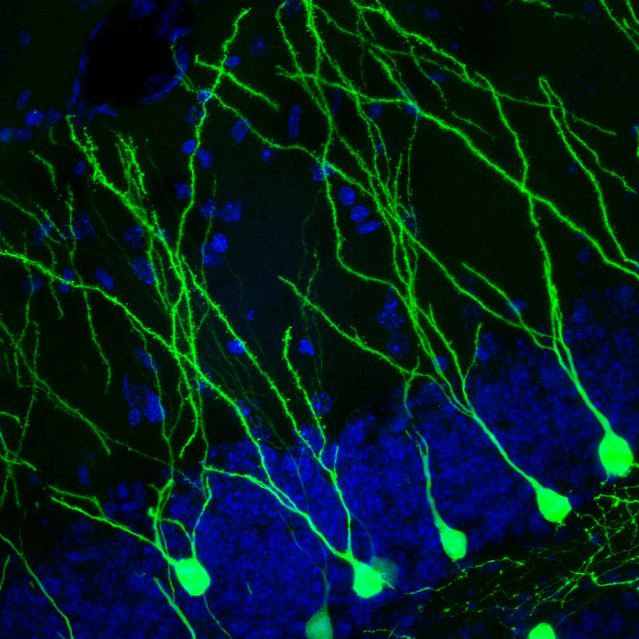Memory
Aerobic Activity Stimulates Neurogenesis (Birth of Neurons)
Aerobic exercise causes neurogenesis, which improves memory function.
Posted June 23, 2016

Do you need motivation to be more physically active? If so, neuroscientists at the National Institute of Aging have captured vivid color images that illustrate how aerobic exercise stimulates the production of a special protein that triggers neurogenesis (birth of neurons) in the brain.
A decade ago, when I published The Athlete’s Way, I wrote extensively about a cutting-edge discovery by neuroscientists that aerobic exercise releases brain-derived neurotrophic factor (BDNF) which stimulates the birth and growth of neurons via neurogenesis. Colloquially, BDNF is referred to as ‘Miracle-Gro’ for the brain because it acts like fertilizer to make neuronal growth more robust.
In recent years, I’ve reported on a wide range of studies which have pinpointed how the release of BDNF increases brain volume, which improves cognitive function and memory, as well as reduces the risk of dementia.
Today, for the first time, a groundbreaking study was published which presents breathtaking images of a protein produced in our muscles (cathepsin B or 'CTSB') which fuels exercise-induced neuron growth. This is a potentially revolutionary discovery.
The June 2016 study, “Running-Induced Systemic Cathepsin B Secretion Is Associated with Memory Function," appears today in the journal Cell Metabolism.
What makes the discovery of another exercise-induced agent being responsible for neurogenesis especially exciting is that cathepsin B can be directly traced from the muscles to the brain, in mice. Also, after exercising aerobically, CTSB protein levels increase in the blood of mice, monkeys, and humans.
In a statement, senior author, Henriette van Praag, a neuroscientist at the National Institute on Aging, said, "We wanted to cast a wide net. Rather than focus on a known factor, we did a screen for proteins that could be secreted by muscle tissue and transported to the brain, and among the most interesting candidates was cathepsin B.”
Aerobic Exercise Triggers Neurogenesis, Which Improves Memory Function
After making the association between aerobic exercise, cathepsin B, and neurogenesis, van Praag and her colleagues compared memory recall in normal mice with a group of mice lacking the ability to produce cathepsin B under both sedentary and running conditions.
Over the course of seven days, both sets of mice were given a daily swim test in a water maze. While navigating this maze, a mouse is placed in a small pool of water and must learn to swim directly to a hidden platform that is submerged just below the water's surface.
After doing this task repeatedly for a few days, normal mice will eventually learn and remember the location of the platform. However, when both groups ran on a wheel before their daily swim test, the normal mice were better able to recall the location of the platform, while the mice unable to produce cathepsin B could not remember its location.
"Nobody has shown before cathepsin B's effect on spatial learning," says van Praag, "We also have converging evidence from our study that cathepsin B is upregulated in blood by exercise for three species—mice, Rhesus monkeys, and humans. Moreover, in humans who exercise consistently for four months, better performance on complex recall tasks, such as drawing from memory, is correlated with increased cathepsin B levels."
Conclusions: More Research Is Needed on CTSB and Neurogenesis
Moving forward, the researchers are going to investigate how cathepsin B is crossing the blood-brain barrier and how it activates neuronal signaling, growth, and connections. There are also a variety of questions surrounding whether this protein behaves differently in various species, and how the production of CTSB may change with age. Stay tuned for more on these findings.
"Overall, the message is that a consistently healthy lifestyle pays off," van Praag concluded. "People often ask us, how long do you have to exercise, how many hours? The study supports that the more substantial changes occur with the maintenance of a long-term exercise regimen."
To read more on aerobic exercise stimulating neurogenesis, check out my previous Psychology Today blog post,
- "More Proof That Aerobic Exercise Can Make Your Brain Bigger"
- "What Makes Aerobic Exercise Like Miracle-Gro for Your Brain?"
- "Want to Bulk Up Your Brain? Burn Some Calories Via Exercise"
- "Why Does Aerobic Activity Improve Cognitive Function?"
- "Physical Activity Is the No. 1 Way to Keep Your Brain Young"
- "This Is Why Aerobic Exercise Is Miracle-Gro for Your Brain"
- "Can Physical Activities Improve Fluid Intelligence?"
- "Superfluidity: Fluid Intelligence Goes Beyond Brain Size"
© 2016 Christopher Bergland. All rights reserved.
Follow me on Twitter @ckbergland for updates on The Athlete’s Way blog posts.
The Athlete’s Way ® is a registered trademark of Christopher Bergland.




